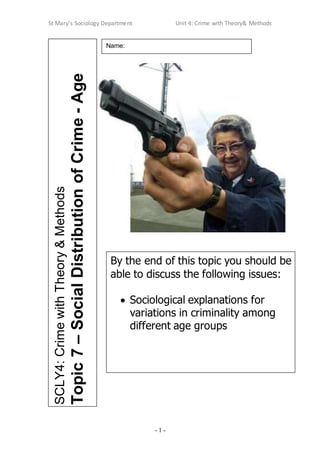
SociologyExchange.co.uk Shared Resource
- 1. St Mary’s Sociology Department Unit 4: Crime with Theory& Methods - 1 - SCLY4: Crime with Theory & Methods Topic 7 – Social Distribution of Crime - Age Name: By the end of this topic you should be able to discuss the following issues: Sociological explanations for variations in criminality among different age groups
- 2. St Mary’s Sociology Department Unit 4: Crime with Theory& Methods - 2 - Age & Offending The peak age for offending is between 15 and 18, with young males much more likely to offend than young females (although this gap is closing). Young people have always been over-represented in the crime statistics, despite each generation of adults creating their own moral panic about the ‘youth of today’, and complaining that it ‘was never like this in my day’. Official statistics show that roughly half of all those convicted are aged 21 or under, and a 2002 self-report study found that almost half of Britain’s secondary school students admitted having broken the law. While most young people will break the law at some time, their offences are usually trivial, opportunistic, short-lived and isolated incidents, and peer-group related, such as under-age drinking, vandalism and shoplifting. Explanations for links betweenage& crime: Status frustration- Cohen (1971) argues that the peer group can make up for the lack of status within school, employment or the family. How might status frustration help explain both why many young people occasionally get involved in illegal or deviant behaviour, and why many also eventually give it up? Peergroup status & working class focal concerns – Miller (1962) says that w/c young males are more like to get involved in criminal behaviour, because of the focal concerns of their subculture, which include toughness, smartness, excitement, fatalism, a desire for freedom and an acceptance of violence as a normal part of life. Suggest reasons why the ‘focal concerns’ identified by Miller might be more likely to lead younger working class people rather than older people into trouble with the law:
- 3. St Mary’s Sociology Department Unit 4: Crime with Theory& Methods - 3 - Edgework – Katz (1988) and Lyng (1990) argue that much delinquency is motivated by ‘edgework’ or thrill seeking, and that this applies increasingly to girls and young m/c people as well. The peer group& weakened socialbonds – Control Theory (Right Realism) suggests that criminal behaviour is likely if the bonds to family and society are weakened, and teenagers are more interested (in general) in the approval of their peer group than their family or wider society – especially if they are experiencing status frustration. Delinquency,drift & techniques of neutralisation – Matza (1964) suggests that young people go through a period of ‘drift’ where they are no longer children, but not yet part of the adult world. During this period, society’s moral bonds are weakened. However, the techniques of neutralisation used by juvenile delinquents show that they ultimately have the same moral values as the rest of society, and feel guilt about their actions. Explain how, with examples of your own, the techniques of neutralisation identified by Matza might show some commitment among offenders to mainstream values: Outline the techniques of neutralisation you have adopted in your life to justify or explain any deviant or delinquent behaviour you have been involved in, whether criminal or not: Policestereotyping– for all of the above reasons, young people fit the police stereotype of a ‘typical offender’, and so they are more likely to monitored, stopped, questioned, arrested, charged and convicted.
- 4. St Mary’s Sociology Department Unit 4: Crime with Theory& Methods - 4 - Explain, with examples, how the lifestyles of the young might a) give them greater opportunity to commit crime; and b) expose them to greater risk of being victims of crime, than those in other age groups Have you ever been involved in any delinquent activity? Which, if any, of the various explanations suggested above do you think explain your delinquency? Explain your answer: Plan an answer to the following question: Examine sociological explanations for the high proportion of young people shown in the official statistics on crime.